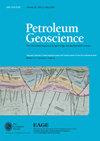化学地层学结合生物地层学、沉积学和岩石地层学对沙特阿拉伯东部海西不整合的定义
IF 2.1
4区 地球科学
Q3 GEOSCIENCES, MULTIDISCIPLINARY
引用次数: 0
摘要
以下化学地层学研究是在沙特阿拉伯东部14口井中发现的古生代沉积物上进行的。通过电感耦合等离子体光学发射光谱法(ICP-OES)和电感耦合等离子体质谱法(ICP-MS)共分析了1500个样品,获得了周期表中从Na到U的48种元素的数据。其目的是利用化学地层学,结合现有的生物地层学、岩石地层学和沉积学数据,来定义每口井中的海西不整合,并识别其上下的地层边界。这是必要的,因为不整合侵蚀到每口井的不同地层水平,泥盆纪,志留纪和奥陶纪沉积物在其正下方的邻近位置发现。在缺乏化学地层学、生物地层学和沉积学数据的情况下,通常很难单独使用岩石地层学来定义这一边界和其他边界,因为许多地层层段产生了类似的伽马射线(GR)测井趋势。例如,低“块状”GR响应是石炭系加扎勒段和奥陶纪萨拉组的典型特征。同样,志留系Sharawra段和志留系-泥盆纪Tawil组都产生了“ratty”GR趋势。每个地层成员和地层都被发现具有独特的化学地层学、生物地层学、沉积学和/或电缆测井特征。本文章由计算机程序翻译,如有差异,请以英文原文为准。
Definition of the Hercynian Unconformity in eastern Saudi Arabia using chemostratigraphy in conjunction with biostratigraphy, sedimentology and lithostratigraphy
The following chemostratigraphy study was conducted on Paleozoic sediments encountered in 14 wells in eastern Saudi Arabia. A total of 1500 samples were analysed by inductively coupled plasma optical emission spectrometry (ICP-OES) and inductively coupled plasma mass spectrometry (ICP-MS), with data acquired for 48 elements, ranging from Na to U in the periodic table. The aim was to utilize chemostratigraphy, in conjunction with existing biostratigraphic, lithostratigraphic and sedimentological data, to define the Hercynian Unconformity in each well and to recognize stratigraphic boundaries occurring above and below it. This was necessary as the unconformity eroded to different stratigraphic levels in each well, with Devonian, Silurian and Ordovician sediments found immediately below it in adjacent locations. In the absence of chemostratigraphic, biostratigraphic and sedimentological data, it is often very difficult to define this boundary and others using lithostratigraphy alone as many stratigraphic intervals yield similar gamma-ray (GR) log trends. For example, a low ‘blocky’ GR response is typical of both the Carboniferous Ghazal Member and the Ordovician Sarah Formation. Similarly, both the Silurian Sharawra Member and the Silurian–Devonian Tawil Formation produce a ‘ratty’ GR trend. Each stratigraphic member and formation was found to have distinctive chemostratigraphic, biostratigraphic, sedimentological and/or wireline log signatures.
求助全文
通过发布文献求助,成功后即可免费获取论文全文。
去求助
来源期刊

Petroleum Geoscience
地学-地球科学综合
CiteScore
4.80
自引率
11.80%
发文量
28
审稿时长
>12 weeks
期刊介绍:
Petroleum Geoscience is the international journal of geoenergy and applied earth science, and is co-owned by the Geological Society of London and the European Association of Geoscientists and Engineers (EAGE).
Petroleum Geoscience transcends disciplinary boundaries and publishes a balanced mix of articles covering exploration, exploitation, appraisal, development and enhancement of sub-surface hydrocarbon resources and carbon repositories. The integration of disciplines in an applied context, whether for fluid production, carbon storage or related geoenergy applications, is a particular strength of the journal. Articles on enhancing exploration efficiency, lowering technological and environmental risk, and improving hydrocarbon recovery communicate the latest developments in sub-surface geoscience to a wide readership.
Petroleum Geoscience provides a multidisciplinary forum for those engaged in the science and technology of the rock-related sub-surface disciplines. The journal reaches some 8000 individual subscribers, and a further 1100 institutional subscriptions provide global access to readers including geologists, geophysicists, petroleum and reservoir engineers, petrophysicists and geochemists in both academia and industry. The journal aims to share knowledge of reservoir geoscience and to reflect the international nature of its development.
 求助内容:
求助内容: 应助结果提醒方式:
应助结果提醒方式:


